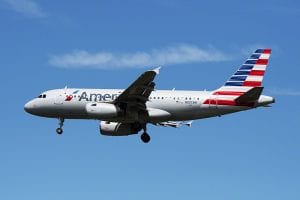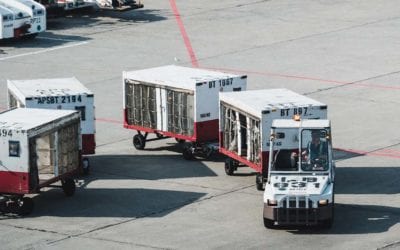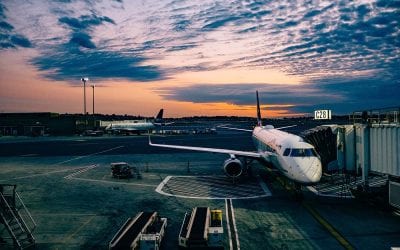The FAA and the airlines are battling the FCC, Verizon and AT&T over the cellular giants’ 5G C-band deployment. The FAA claims it interferes with take-offs and landings.
 Most air travelers in the U.S. have heard about the hullabaloo between the airline industry and the U.S. cellular industry. The problem centers around Verizon’s and AT&T’s deployment of a particular kind of 5G C-band.
Most air travelers in the U.S. have heard about the hullabaloo between the airline industry and the U.S. cellular industry. The problem centers around Verizon’s and AT&T’s deployment of a particular kind of 5G C-band.
In a nutshell, the airlines and the Federal Aviation Administration (FAA) claim that the recently approved 5G C-band deployment will dangerously interfere with airplanes taking off and landing at U.S. airports during times of low visibility. The claim is backed by a report from the Radio Technical Commission for Aeronautics (RTCA). On the other hand, the Federal Communications Commission (FCC) and the cellular service providers cite an FCC report that states that the studies warning of the problem do “not demonstrate that harmful interference would likely result under reasonable scenarios (or even reasonably “foreseeable” scenarios.)”
Verizon and AT&T have put their planned 5G C-band deployment cellular service on hold near airports.
For now, both Verizon and AT&T have agreed to delay their planned 5G C-band deployment within two miles of airports, thus eliminating the potential interference with both commercial and general aviation aircraft. If you’re wondering if you can safely fly in the U.S., the answer is yes, you can.
I know this is technical, but to understand the scope of the 5G C-band deployment problem, we need to understand more about 5G C-Band cellular service and aircraft radar altimeters.
To understand the problem air travelers must learn a little about 5G C-band cellular service and how airplane radar altimeters work.
There are three kinds of 5G deployment that enable “high speed” data services. The 5G C-band deployment is the one that concerns the airlines and FAA. C-Band is capable of speeds in the range of 200–800Mbps, yet has a range similar to the slower 4G service. That means for a significant speed increase, C-band doesn’t require nearly the investment that the higher speed millimeter 5G service requires.
C-band operates using radio frequencies at 3.7–4.2GHz. Verizon and AT&T purchased the bulk of the use of this radio spectrum for a combined $68 billion. When you spend that kind of cash, needless to say, you don’t want it sitting idle.
Aircraft in the U.S. and around the world use radar altimeters. These instruments measure the plane’s altitude above the terrain underneath them. They send out a beam of radio waves that travel to the ground and then reflect back to the aircraft. How long it takes to reflect back tells the aircraft its altitude.
The radar altimeter is the sole sensor onboard an aircraft that can tell pilots what clearance they have over the terrain below the plane.
In order to land, particularly in conditions of low visibility, for example, pilots must know where they are in relation to the ground under them, including the runway and any buildings, mountains, hills, etc. that they must clear on their way to the landing. According to a report from the International Air Transport Association (IATA), “The radar altimeter is … the only sensor onboard an aircraft providing a direct measurement of the aircraft’s clearance over the terrain or other obstacles.”
The crux of the problem is that there is frequency overlap between 5G C-band cellular service and aircraft radar altimeters.
Across the globe, radar altimeters frequencies are 4.2–4.4GHz. As stated above, the top frequency of C-band is 4.2GHz. Therein lies the problem. C-band cellular service could interfere with aircraft radar altimeters.
Moreover, according to experts, many altimeters in use today don’t use stabilization systems to prevent their signal from bleeding beyond their assigned frequencies. In other words, some of the radar altimeters may use frequencies somewhat below 4.2GHz.
Europe’s 5G C-band frequencies don’t overlap with aircraft radar altimeters.
Europe is already using 5G C-band cellular service, but their C-band use is 3.4–3.8GHz. At that range they have enough breathing room to prevent interference between cellular and radar altimeter frequency use.
During low visibility landings, it’s essential that aircraft radar altimeters provide accurate information to pilots. For commercial aircraft, we know from an FAA report that many Boeing planes are safe from interference. We also know that Airbus planes are generally safe, along with the Embraer 170 and 190 regional jets. According to the FAA, “An estimated 78 percent of the U.S. commercial fleet” is safe to perform low visibility landings at airports with 5G C-band deployment. The FAA is continuing its evaluation.
Some aircraft are safe from interference, but others like the Boeing 787 apparently have a potential interference problem.
Right now, however, the FAA is warning that they found anomalies with radar altimeters on Boeing 787–8, 787–9 and 787–10 aircraft due to 5G C-band interference. The FAA further warns,
“During landing, this interference could prevent proper transition from AIR to GROUND mode, which may have multiple effects. … Therefore, the presence of 5G C-Band interference can result in degraded deceleration performance, increased landing distance, and runway excursion.”
There are also thousands of general aviation planes with radar altimeters and many of them could suffer from 5G C-band interference, too.
The problem seems to have started during the Trump Administration.
How did the cellular and aviation industries get to this point? Personally, I lay the blame on the Trump Administration. The FCC and the cellular industry had been talking about the 5G revolution for years. Everyone knew this was coming.
During the Trump Administration, the cellular industry was moving toward 5G. The National Telecommunications and Information Administration (NTIA) was supposed to create a national radio spectrum plan. It never happened, mostly due to a lack of leadership in the last half of the Trump Administration, in my opinion. David Redl, head of NTIA, resigned in May 2019, as did Mike Platt, NTIA Assistant Secretary for Legislative and Intergovernmental Affairs. Redl was never replaced and the NTIA floundered.
Today, the airlines and the traveling public are asking how can we make our airports safe from 5G C-band now. In the future, the nation must determine how we can fix the mess while allowing cellular users to use 5G C-band’s high-speed cellular data promise.
The telecoms have postponed 5G C-band deployment near airports. A long-term solution must be devised.
For now, both Verizon and AT&T have agreed to not deploy 5G C-band within two miles of any U.S. airport, so our U.S. airports should be safe.
Boeing suggested a frequency buffer between the cellular industry 5G C-band deployment and radar altimeter use. Boeing proposed prohibiting the cellular industry from using frequencies at 4.1GHz and above. The FCC doubled the buffer in their report and order of March 2020. They set the top limit at below 4.0GHz. Please note that this is above what’s used in Europe. I believe that’s likely why the FAA and the airline industry haven’t accepted the FAA buffer.
The Biden Administration needs to do more testing to see if a frequency buffer can work and require that radar altimeters are designed to eliminate interference problems.
I propose that the Biden Administration should immediately expand their radar altimeter testing and evaluation program to determine if the proposed FAA buffer, starting at a 4.0GHz limit, is enough to prevent 5G C-band deployment interference with radar altimeters.
I further propose that all radar altimeters should all be required to use stabilization systems to ensure they operate at their assigned frequencies. They should be designed to safely handle limited interference. Once radar altimeters with that design are ready, all commercial aircraft and general aviation aircraft equipped with radar altimeters should be upgraded.
(Image: American Airlines A319 landing at Philadelphia International Airport. Copyright © 2018 NSL Photography. All Rights Reserved.)
READ ALSO:
The new EU data protection law — GDPR — affects vacation photos
Travel agent benefit may be the best travel insurance
After many years working in corporate America as a chemical engineer, executive and eventually CFO of a multinational manufacturer, Ned founded a tech consulting company and later restarted NSL Photography, his photography business. Before entering the corporate world, Ned worked as a Public Health Engineer for the Philadelphia Department of Public Health. As a well known corporate, travel and wildlife photographer, Ned travels the world writing about travel and photography, as well as running photography workshops, seminars and photowalks. Visit Ned’s Photography Blog and Galleries.



